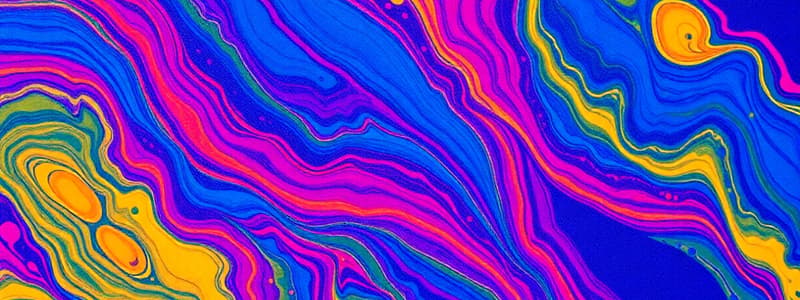Podcast
Questions and Answers
What is the primary classification of dyes based on their solubility in water?
What is the primary classification of dyes based on their solubility in water?
- Natural and synthetic dyes
- Soluble and insoluble dyes (correct)
- Acidic and basic dyes
- Reactive and direct dyes
Which type of dye is known for its ability to form covalent bonds with the fibers?
Which type of dye is known for its ability to form covalent bonds with the fibers?
- Direct dyes
- Basic dyes
- Disperse dyes
- Reactive dyes (correct)
Which category of dye is typically used for cellulose fibers?
Which category of dye is typically used for cellulose fibers?
- Basic dyes
- Acid dyes
- Direct dyes (correct)
- Metal complex dyes
Which type of dye is primarily suited for synthetic fibers like polyester?
Which type of dye is primarily suited for synthetic fibers like polyester?
Which of the following is a characteristic of natural dyes?
Which of the following is a characteristic of natural dyes?
Flashcards
What are types of color?
What are types of color?
Different varieties of color used in various applications.
What is a color?
What is a color?
A visual sensation produced by light waves of various wavelengths.
What are pigments?
What are pigments?
Subtances that absorb certain colors and reflect others.
What are dyes?
What are dyes?
Signup and view all the flashcards
How are colorants used?
How are colorants used?
Signup and view all the flashcards
Study Notes
Types of Dyes
- Dyes are substances that absorb light of specific wavelengths, giving a material color. They are crucial in textile dyeing, coloring plastics, and other applications
- Natural dyes have been used for centuries, derived from plants, animals, and minerals. Examples include indigo from plants, cochineal from insects, and madder root
- Synthetic dyes, created in laboratories, are commercially much more prevalent today. These offer wider color ranges, brighter hues, and often a lower price compared to natural alternatives
- Synthetic dyes are widely used in textiles, plastics, food, and cosmetics. They are crucial in the clothing and fashion industry
- The chemical structure of a dye significantly impacts its properties. These include the dye's color, fastness to light, washing, and other factors
- Different types of dyes are classified based on their chemical structures and properties. Categories include azo dyes, anthraquinone dyes, Vat dyes, and more
- Azo dyes are a large class of synthetic dyes, often bright and versatile. They contain azo (-N=N-) groups in their molecular structure
- Anthraquinone dyes also have high tinctorial strength and are widely used in textile dyeing
- Vat dyes are applied to fabric in a reduced, colorless state. They change color during an oxidation process after application, resulting in substantial color depth
- Disperse dyes are for synthetic fibers, and are often used in the printing of fabrics
- Reactive dyes form strong chemical bonds with the fibers they color. Because of the chemical bonds, the dyes are inherently fast to washing, making them a popular choice for certain fabrics
- Direct dyes are soluble in water, and easily absorbed by natural fibers like cotton and linen
- Acid dyes display a strong affinity for protein fibers such as wool and silk, dissolving in acidic solutions
- Basic dyes form bonds with natural fibers such as silk and wool, dissolving in an alkaline solution
- Several standards and regulations control the use of dyes, especially synthetic ones, to ensure safety
- Concerns surrounding potential health effects from synthetic dyes exist. Ongoing research seeks to address the possible risks. The safety profile of specific dyes can vary greatly
- Environmental impact of synthetic dye production and disposal is a key consideration in their usage. These include issues of water contamination, waste disposal and the overall environmental footprint of the manufacturing process
- Applications of dyes are vast, spanning textile industries, plastics, paints, cosmetics, and food coloring. This versatility highlights their importance in many aspects of modern life
- Dyes provide color and aesthetics to various materials. Aesthetic value often contributes to consumer appeal
- The choice of dye often relies on the specific application (e.g., natural fibers vs. synthetic). The desired color fastness (e.g., washing, light fastness) plays a vital role. A balance between color, cost, and potential adverse effects from different dyes is necessary
- The manufacturing processes for dyes range from simple to complex, depending on the chemical nature of the dye. This diversity underpins the significant industrial significance of dyes.
Studying That Suits You
Use AI to generate personalized quizzes and flashcards to suit your learning preferences.




